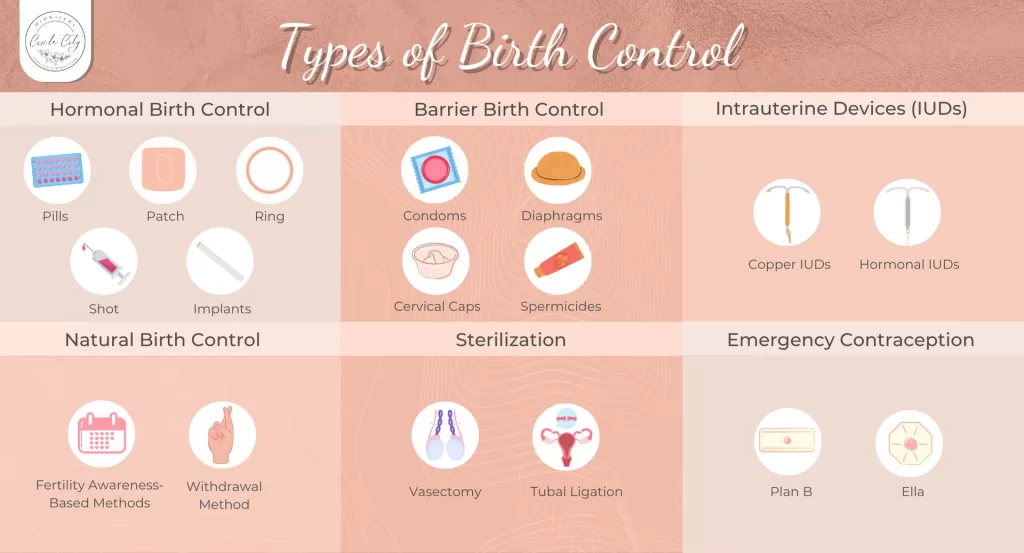When it comes to navigating the extensive landscape of birth control options, many women find themselves at a crossroads, especially when unwanted side effects arise. With recent advancements, including the introduction of new contraceptive pills and enhanced access to hormonal IUDs, women now have a broader selection to consider. Contraceptive pills and hormonal IUDs, like Mirena and Kyleena, each come with their unique profiles and potential side effects, making informed decisions crucial. However, mood changes contraception remains a significant concern for many, as hormonal methods can affect emotional well-being. Understanding the differences between options such as copper IUDs and traditional pills, as well as discussing contraception side effects, empower women to choose the method that best suits them.
Exploring contraceptive methods can be overwhelming, especially with so many alternatives available. Various types of birth control, from hormonal methods to non-hormonal devices, offer women the flexibility to manage their reproductive health. As more individuals look for ways to maximize their well-being, understanding the impact of mood fluctuations and potential side effects of each option is essential. Long-acting reversible contraceptives (LARCs), including both hormonal and copper IUDs, provide effective long-term solutions for those seeking alternatives to traditional pills. By evaluating diverse contraception options, women can find the approach that aligns with their health needs and lifestyle.
Understanding Birth Control Options
When considering various birth control options, it’s essential to evaluate the range of methods available to find what works best for your body and lifestyle. Recently, new contraceptive pills like Yaz and Yasmin have been added to subsidized programs, making them more affordable. By expanding the options available under the Pharmaceutical Benefits Scheme (PBS), women now have a greater opportunity to explore suitable contraceptive choices—especially those who may have experienced side effects from previous options, such as mood changes associated with hormonal pills.
In addition to the new subsidized contraceptive pills, long-acting reversible contraceptives (LARCs) such as hormonal and copper IUDs offer alternative methods for those seeking effective birth control. Increasing awareness of these options is important, as studies show a disparity in uptake compared to other developed countries. While many women feel comfortable with pills, exploring diverse methods can empower individuals to find a solution that suits their health needs.
The Impact of Hormonal IUDs
Hormonal IUDs like Mirena and Kyleena often provide a suitable alternative for women who encounter mood-changing side effects from oral contraceptives. These IUDs release a small amount of progestin hormone directly into the uterus, thus minimizing exposure to estrogen and avoiding broader systemic hormonal effects. Many users report reduced side effects compared to the oral contraceptives, enabling them to manage their reproductive health without suffering from the psychological impacts associated with hormonal fluctuations.
Additionally, IUDs are long-acting, providing effective contraception for several years without the need for daily attention. This continual release of hormones can stabilize periods and reduce the risk of mood-related side effects that some women experience from traditional contraceptive pills. Nevertheless, discussions of insertion and removal costs, along with the availability of pain relief during these procedures, remain crucial in supporting women’s choices.
Contraception Side Effects: What You Should Know?’,’paragraphs’:[{
Frequently Asked Questions
What are the main birth control options available for women experiencing side effects?
Women experiencing side effects from hormonal contraception have several options. These include trying different contraceptive pills with alternatives like estradiol and nomegestrol, which may have fewer mood-related side effects. Additionally, hormonal IUDs such as Mirena or Kyleena and non-hormonal options like the copper IUD offer alternatives that don’t impact mood as much. It’s important to consult with a healthcare provider to find the best fit for individual needs.
How do hormonal IUDs compare to contraceptive pills in terms of side effects?
Hormonal IUDs, like Mirena, can provide long-acting contraception with potentially reduced mood-related side effects compared to traditional contraceptive pills. Many women report that they experience fewer hormonal fluctuations with IUDs. However, individual experiences vary, and while some may prefer hormonal IUDs for their effectiveness and convenience, others may still face side effects. It is crucial to discuss these options with a healthcare provider.
What are the potential mood changes associated with contraceptive pills?
Mood changes are a common side effect associated with various contraceptive pills. Some women report symptoms such as anxiety, irritability, or depression after starting hormonal contraception. The connection between contraception and mood is well-documented, but individual responses can vary. It’s advisable for women experiencing these changes to consult with their healthcare providers about alternative birth control options with potentially fewer mood-related effects.
Can switching from hormonal pills to a copper IUD alleviate contraception side effects?
Switching from hormonal contraceptive pills to a copper IUD may alleviate some of the mood-related side effects linked to hormonal birth control. The copper IUD is a non-hormonal option that many find suitable. However, it may come with its own set of challenges, like heavier periods or cramping. Women considering this switch should discuss it with their healthcare provider to evaluate the best contraceptive options for their health and lifestyle.
What steps can women take if they experience side effects from hormonal contraceptives?
If women experience side effects from hormonal contraceptives, they should first consult with their healthcare provider to reassess their birth control options. Alternatives include trying different contraceptive pills with distinct hormonal compositions, opting for a hormonal IUD, or considering non-hormonal methods like the copper IUD. Regular follow-ups and open discussions with healthcare professionals are essential for managing side effects effectively.
Are there any new contraceptive options available under the Pharmaceutical Benefits Scheme (PBS)?
As of March 2025, new contraceptive options, including Yaz and Yasmin contraceptive pills, have been included in the Pharmaceutical Benefits Scheme (PBS) in Australia. This initiative aims to improve accessibility and affordability for women facing side effects from existing options. The PBS now also supports hormonal IUD insertions and removals, enabling a broader selection of methods for managing contraception effectively.
What are the risks associated with hormonal contraceptives like Yasmin?
Hormonal contraceptives such as Yasmin have been associated with a slightly increased risk of complications, including blood clots. While such occurrences are rare, women using these pills should remain vigilant to any unusual symptoms and seek medical advice promptly. Regular consultations with healthcare providers can help assess ongoing suitability for any hormonal contraceptive.
How can women improve their contraceptive choice with new options available?
Women can improve their contraceptive choice by actively exploring the newly added birth control options under the PBS, discussing potential side effects and personal health considerations with healthcare providers. Taking advantage of the expanded list of contraceptive pills, hormonal IUDs, and non-hormonal methods like the copper IUD can lead to a suitable contraceptive method that aligns with their health needs and lifestyle.
| Aspect | Details |
|---|---|
| Recent Changes in Birth Control | A contraceptive pill added to PBS for the first time in 30 years (Yaz and Yasmin), reducing costs significantly. |
| Financial Benefits | Cost reduction means pills will be priced at $30.80 with a concession card, benefiting 50,000 women annually. |
| Subsidy for IUDs & Implants | Increased Medicare rebates for the insertion/removal of hormonal IUDs and implants. Potential savings of up to $400 per year for about 300,000 women. |
| Mood Changes Due to Hormonal Contraception | Some women experience anxiety, irritability, or depression. It’s essential for women to have their experiences heard and acknowledged. |
| Alternative Contraceptive Options | Pills like Zoely and Qlaira may have fewer mood-related side effects. Non-hormonal options like copper IUDs are also available. |
| Risk Factors | Some pills (like Yasmin) carry a higher risk of blood clots. Regular review of contraceptive methods is crucial. |
| Education & Awareness | Ongoing education and awareness about other contraceptive options are essential to improve usage. |
Summary
Birth control options are an essential aspect of reproductive health, and with recent changes in Australia’s healthcare system, women now have more accessible choices than ever before. The inclusion of new contraceptive pills in the Pharmaceutical Benefits Scheme (PBS) signifies a substantial shift towards affordable birth control solutions. Moreover, women experiencing unwanted side effects like mood changes can benefit from a greater array of options, including hormonal and non-hormonal methods. This truly represents a progressive step towards empowering women to take control of their health, ensuring that their voices are heard and their needs are met.
The content provided on this blog (e.g., symptom descriptions, health tips, or general advice) is for informational purposes only and is not a substitute for professional medical advice, diagnosis, or treatment. Always seek the guidance of your physician or other qualified healthcare provider with any questions you may have regarding a medical condition. Never disregard professional medical advice or delay seeking it because of something you have read on this website. If you believe you may have a medical emergency, call your doctor or emergency services immediately. Reliance on any information provided by this blog is solely at your own risk.







